Maruja, as it was fondly called by her loved ones, was the wife of Eduardo Frei Montalva. Her role as First Lady during the presidential term of her husband made her at national and international level. However, she was more than the companion of one of the more influential presidents of our country in the XX century, and during Women’s Month we want to emphasise this tenacious woman.
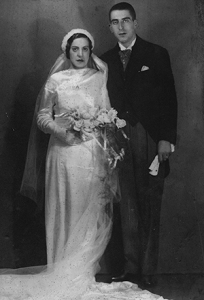
Matrimonio de Eduardo Frei Montalva y María Ruiz – Tagle. 27 de abril de 1935.
Very few is known about the background during María Ruiz- Tagle Jiménez childhood. It is known she was born in Santiago April 15th of 1913 and her parents were Claudia Jiménez y Alfredo Ruiz-Tagle, both from Valdivia city . Moreover, she had a brother, Alfredo, that was born in 1911, who was a priest and created Fundación Mi Casa, an important work dedicated to safeguard and educate vulnerable children and adolescents in our country.
During her adolescence she studied at, in the that time, Colegio de las Monjas de la buena Enseñanza, now, Colegio Compañía de María in Seminario street . At fourteen years old, when she lived with her family at Portugal street, close by the school her brother studied and where he had a friend and classmate that lived a few blocks from them that in a shorter time was going to be a very important person in the life of young Marujita: Eduardo Frei Montalva. It was Alfredo, indeed, who introduced them in 1927 and invite he over their house, and at the contrary that was going to happen further on, this first meeting did not cause a major impression on her. It was an interview she gave to Vea magazine in which she points to journalist Raquel Correa:
“When I first met him, I didn’t like him. He was too serious ”
María is described as a simple but very lively woman. She herself used to say she liked the parties and that feature own of her youth contrasted with the impression Frei cause don her the first time they met.
It was only until 1929 when María y Eduardo begin a formal relationship, as it was typical on those years. He visited her at her house, very few romantic dates and they were never alone. There was a lot of letters, especially, when spent their vacations outside Santiago and was not able to see each other. A large part of those letters are preserved in the Historical Archive of Museo Eduardo Frei Montalva in which we can see the profound love they professed one another, and it was from the common idyllic romance between teenagers to a mature, consolidated and firm love.
Several events marked the couple during previous marriage years in which María always supported her boyfriend. Frei initiates his path through politics during college years and made his studies compatible with Catholic Student Association (ANEC in spanish) meetings, his work, among other activities. His health was considerable damaged towards the end of 1931, at the point where he had to spent a period in Sanatorio de Peña Blanca because of a lung infection which meant a couple of months absolute rest . Given the circumstances, María wrote to the hospital, at least every two days to tell him what she was doing during his absence, extending the greetings of his future father and mother- in- law, and being pending about his recovery. “How are you today, handsome tall? Are you feeling better?” She wrote on January of 1932… You don’t know how much I miss you… What would I be without your affection, loving little Frei!?..” Those are the tender words, apart from sweets, blancmange and other gifts she sent to the hospital.
Another important fact, for both lives, was the appointment of Frei Montalva as the director of a newspaper from Iquique, “El Tarapacá”, which involved move to the north, leaving his future wife in Santiago for several months before the wedding. She took on the necessary details for the wedding celebration and the future life in Iquique. As she herself told in her letters to Frei, during those months she bought fabrics to have sheets, blankets and more.
Despite the hustle and bustle that means to prepare marriage life, María always had time to maintain a smooth correspondence with her boyfriend, keeping her sweet character and good mood, joking even with her wedding dress and her appearance, telling him she would look as “a fly in the milk, even though I would be the charming dark complexion lady of little Frei”.
After six years of courtship, María and Eduardo got married at the end of April in 1935 in a ceremony celebrated in Instituto de Humanidades chapel and a reception in the house of the bride as it was used in that time. They had a Little honeymoon at coastal zone in Fifth Region and then sailed to Iquique to begin their own family. Soon after, their first daughter, Irene, was born.
There is not great deal of background about her life in Iquique but we do know that during her stay in the north, she kept very good memories. At least, that was what she commented in an interview in March 1996.
In 1937, the family decided return to Santiago. When they came back, bought a incipient field in Providencia district where began the construction of a house in which they will live in 1942 when the first son was born: the sixth member of the family.
The couple had seven children in all, four women and three men. After the eldest daughter was born back in Santiago, Carmen, Isabel, Eduardo, Mónica, Jorge y Francisco were born. They have, approximately, two years apart from each other except from Francisco who was born five years after Jorge.
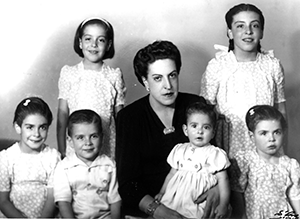
María Ruiz-Tagle junto a seis de sus siete hijos, en 1946.
As a mother of a large family, María Ruiz-Tagle was dedicated to all the details linked to household chores as used in that time. According to an interview made by a group of researchers in 1996- which is kept in few extracts in our Historical Archive- when background information was being collected for the edition of a book about Eduardo Frei Montalva, there was a conversation among some of the daughters and sons of the couple and María left some clues about her character and life.
For example, it is quite clear for us that her role as housewife was very defined and consolidated because not her or mister Eduardo allow other people influenced in housekeeping or the raising of their children. With this in mind is clear that both put their house in order but Mrs. María was more severe while the father seem more permissive, being her who establish rules and monitored children homework. “I was the the witch” she told as a joke in the recording.
In another aspect, one of the highlights was her management and dedication to the finest details. As an example, to make the linings for the books and notebooks and school materials for her children, considering she raised seven and for several years they had a tight Budget. Eduardo Frei himself emphasized the qualities of his wife that aroused profound admiration in him:
“She has given dignity, tranquility, joy and great efficiency to my house, and that is also very important…Let’s not talk about great things but the smaller ones. It is so pleasant to have a house which is clean and in order, between within modesty, distinction. I owe that to my wife, and seven children. They are, although is a tired phrase, my joy and pride”.
Over the time, the political career of her husband was also marking the life of Mrs. María because even though Mr. Eduardo keep a separation between work and home, each political campaign he involved, of his party or his own, meant some kind of change in family daily living. Even with the occasion of 1948 parliamentary elections they traveled with him to the región of Coquimbo for support.
Without doubt, the presidential election of 1964 was the one that more changes brought, especially for Maruja who after that year until 1970 accompanied her husband in a very distant role than she used to, as the First Lady of the Nation during the presidential term of Eduardo Frei Montalva.
In an interview with the famous journalist Raquel Correa, few days after the election of Frei, who in those years worked for “Vea” magazine, María Ruiz Tagle points out she did not feel prepared for beign the First Lady but have quite clear which were going to be her primary focus.
“ How do you feel as the First Lady? -we asked.
I don’t feel like I am yet – she immediately answered-. When I was portrayed in a newspaper as the First Lady, she gave me a terrible impression.[…] This has been a huge change. I cannot get used yet.
[…]
We investigate which is going to be your role as the First Lady. She answered:
-I have been thinking of a lot about that but still don’t have an specific plan. My greatest hope is improve the quality of life people have in communities and, particularly, looking after vulnerable children”.
Considering the shyness she recognises in the interview, Maruja played an unexpected role within his husband government. She transformed the modest functioning that in social matters existed in our country, in a great work that boost the development of chilean women as never seen before.
At the beginning of the presidential term, she founds CEMA Chile, a work in which she was supported by the wives of all of the Cabinet Ministers. To carry out this work, she is allocated in an office in the Palacio de la Moneda” which she went every morning to dedicate the evenings to travelled, along Sergio Ossa, the Centros de Madres of the different communities of Santiago. This task is considered a very important activity for the Promoción Popular agenda made by the government.”
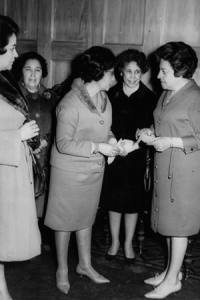
María Ruiz-Tagle junto a un grupo de mujeres alrededor de 1965.
As the work of her relentless work, the Central Relacionadora de Centros de Madres was transformed in a key body and complementary to the Promoción Popular Agenda of her husband. Thousands of women were benefited with education, training and incomes derived from their work. CEMA reach such an organization and efficiency level in the purchase of materials and management of women’s work that quickly paid off and transformed in a guide. It was conceived as an institution dedicated to “give Technical and Organizational promotional services”, besides, it has an economic nature “intended to give work that could be done at home and allow women, mothers of several children, to contribute to the family budget without disregard their care and attention”.
Frei himself remarked publicly in his 1970 May 21th speech,the significant social advance changes achieved by the institution led by his wife, whom he always said he felt very proud because until the end of 1969, already existed about 9000 mother centers, which meant to have approximately 450 thousand of women grouped in organizations.
On the other hand, regards to the economic capacity that organizations reached, to the same date there was been managed the purchase of 70 thousands sewing machines from women, which went in direct benefit to the incomes of their families, since these machine were going to be their basic work tool. In respect of the capacitation of the members, the agreement that CEMA subscribed with the Ministry of Education between 1966 and 1968 benefited 23,329 women.
In short,in his last presidential message, Frei Montalva gave account of the meaningful achievements of the institution lead by María Ruiz-Tagle. Besides, as we can see in the documents preserved in our archive, she directly involved in a lot of aspects of the management of CEMA, as the purchase of materials, consumables, machinery, management of the real estate, coordination of another foundations and visits, supply establishments, sale and work of the centers.
In that way, being an active low profile woman, Mrs. María crossed the walls of her home of Hindenburg Street in Providencia to change the life of thousand of chilean women and their families. For this reason, when in 2012 Investigation Police of Chile (PDI in spanish) published a research under the title “First Ladies of Chile”, dedicate to María Ruíz-Tagle beautiful words that collect in a simple paragraph, some of the characteristic of this woman:
“Quietly, she met the challenges of the political world, those not set from the heart but the will. First for her husband, then for her son. She approached to La Moneda with that typical efficiency thet allowed her, in short time, to embrace and organize thousand of mothers of our country”.
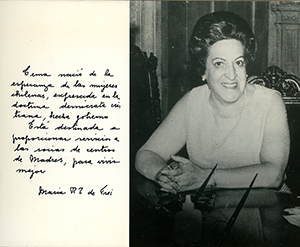
Mensaje de María Ruiz-Tagle publicado en libro de CEMA.
As a result of her work, during her time as a First Lady, and even after, she was awarded domestic and internationally. From humble gifts of the women she helped through CEMA to foreign awards, several of which are exhibited today in Casa Museo EFM as evidence of her efforts.
At the end of her term of First Lady she returned to her life as housewife, mother and also grandmother. Several of her sons and daughters did not longer live in the house of Hindenburg Street because they had already established their own homes so the house was lonelier. At this point we fall in the darkness of having no information regards to the life of María. We just know- because of pictures and a few testimonies quoted on the book of Cristian Gazmuri and PDI before mentioned- that she will accompany her husband not only in the privacy of her home but also in the trips abroad.
So 1981 came and with that began one of the more painful moments of her life. In 1982, January 22th, her husband Eduardo Frei Montalva died. What happened to Mrs. Maruja after that moment? We do not exactly know except that she stayed in the house of Hindenburg Street during several years more and appeared publicly when her son Eduardo took over the Presidency of the Republic in 1994.
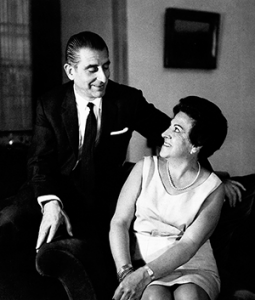 On April 10th of 2001, María Ruíz- Tagle died in a clinic of capital city as consequence of a respiratory deficiency after a pneumonia, that had her interned almost a month at 87 years old.Her passes away, without great ostentatious or displays during her life but leaving behind an indelible mark that maybe she never imagined. At this woman, mother, grandmother, First Lady goodbye were the highest authorities of the country in the Metropolitan Cathedral and great display of popular affection was shown.
On April 10th of 2001, María Ruíz- Tagle died in a clinic of capital city as consequence of a respiratory deficiency after a pneumonia, that had her interned almost a month at 87 years old.Her passes away, without great ostentatious or displays during her life but leaving behind an indelible mark that maybe she never imagined. At this woman, mother, grandmother, First Lady goodbye were the highest authorities of the country in the Metropolitan Cathedral and great display of popular affection was shown.
On the occasion of her death, a lot of people remembered her with loving words and remarking her virtues of which we had talked about lengthily in this article. Among them were the ones of father Miguel Ortega, close friend of the family, referred to her saying:
“Honorable, righteous, good, welcoming, loyal, humble, with infinite ability to serve and listen woman”
Today, when her home transformed in a house museum open every day to welcome who wanted to visit it, we find in each corner the presence of this woman. Her dormitory preserves her clothings, rosary, sewing scissors; the dormitory of her sons exhibits one of the hundreds of notebooks to which she made the fabric linings; a portrait of her accompany us to the living room, and her place at the dining table remind us that was able to charme en the Queen of England, Elizabeth II. But maybe the most important memory is not in this walls but in the heart of her family and the thousands of women that got a head thanks to her, and that could give a decent life to their children because of the will and generosity of Mrs. Marujita.
Comentarios cerrados.